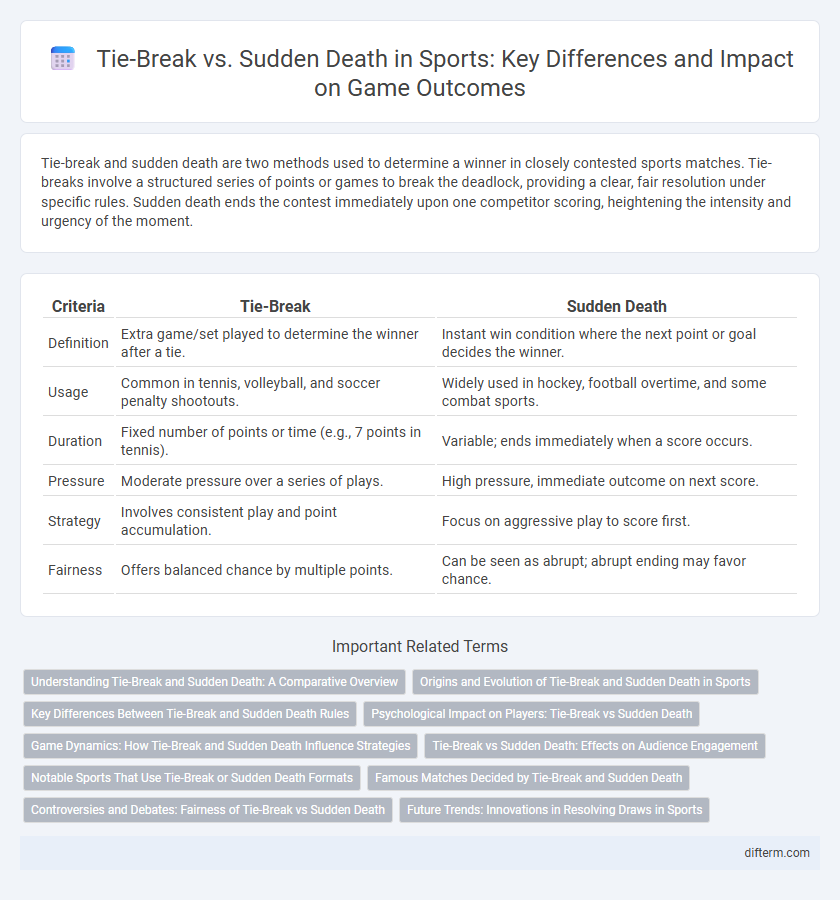Tie-break and sudden death are two methods used to determine a winner in closely contested sports matches. Tie-breaks involve a structured series of points or games to break the deadlock, providing a clear, fair resolution under specific rules. Sudden death ends the contest immediately upon one competitor scoring, heightening the intensity and urgency of the moment.
Table of Comparison
| Criteria | Tie-Break | Sudden Death |
|---|---|---|
| Definition | Extra game/set played to determine the winner after a tie. | Instant win condition where the next point or goal decides the winner. |
| Usage | Common in tennis, volleyball, and soccer penalty shootouts. | Widely used in hockey, football overtime, and some combat sports. |
| Duration | Fixed number of points or time (e.g., 7 points in tennis). | Variable; ends immediately when a score occurs. |
| Pressure | Moderate pressure over a series of plays. | High pressure, immediate outcome on next score. |
| Strategy | Involves consistent play and point accumulation. | Focus on aggressive play to score first. |
| Fairness | Offers balanced chance by multiple points. | Can be seen as abrupt; abrupt ending may favor chance. |
Understanding Tie-Break and Sudden Death: A Comparative Overview
Tie-break systems in sports like tennis and volleyball use a predetermined point structure to resolve draws, emphasizing cumulative scoring to determine the winner. Sudden death formats, common in football and hockey, require the first team to score during extra time or overtime to claim immediate victory. Understanding the strategic implications of tie-break versus sudden death formats aids athletes and coaches in adapting gameplay for optimal performance under high-pressure scenarios.
Origins and Evolution of Tie-Break and Sudden Death in Sports
Tie-break systems originated in tennis during the 1970s to resolve sets quickly and enhance spectator engagement, evolving from the traditional advantage scoring method. Sudden death formats have roots in early 20th-century sports like boxing and golf, designed to produce immediate winners in tied contests without prolonged gameplay. Both methods reflect shifts towards efficiency and heightened competitive drama across various sports disciplines.
Key Differences Between Tie-Break and Sudden Death Rules
Tie-break rules determine a winner by playing a set sequence of points or games, commonly used in tennis to resolve sets tied at 6-6, ensuring a fair and structured conclusion. Sudden death rules end the contest immediately upon a decisive point or play, often utilized in sports like football or boxing overtime to quickly declare a winner. The key difference lies in tie-break's predefined scoring system versus sudden death's immediate game-ending condition.
Psychological Impact on Players: Tie-Break vs Sudden Death
Tie-breaks create sustained mental pressure by demanding consistent precision and strategic thinking over multiple points, intensifying players' focus and emotional regulation. Sudden death scenarios heighten stress with their immediate, high-stakes nature, forcing athletes to manage immediate anxiety and risk in a single decisive moment. The contrasting psychological demands influence players' performance, with tie-breaks favoring endurance in concentration and sudden death emphasizing acute mental resilience.
Game Dynamics: How Tie-Break and Sudden Death Influence Strategies
Tie-break and sudden death formats significantly impact game dynamics by altering player strategies and risk management. Tie-breaks encourage consistent, aggressive point accumulation under timed pressure, optimizing performance over a series of plays, while sudden death demands immediate high-stakes precision, emphasizing error minimization and decisive moves. These differing structures shape tactical approaches, influencing tempo, psychological resilience, and momentum shifts in competitive sports.
Tie-Break vs Sudden Death: Effects on Audience Engagement
Tie-break formats in sports often sustain higher audience engagement by extending competitive tension and allowing more strategic play, compared to sudden death, which delivers immediate resolution but may limit dramatic buildup. Spectators tend to appreciate the prolonged suspense and multiple scoring opportunities in tie-breaks, enhancing emotional investment. Sudden death's abrupt conclusion can lead to polarizing reactions, as its unpredictability offers both thrilling climaxes and anticlimactic finishes, influencing overall viewer satisfaction.
Notable Sports That Use Tie-Break or Sudden Death Formats
Tennis prominently uses the tie-break format to decide sets that reach a 6-6 score, providing a structured and thrilling conclusion without extending match duration excessively. In contrast, sudden death is a hallmark of ice hockey overtime and American football, where the first team to score immediately wins, intensifying the stakes and excitement. Golf employs sudden death playoffs to break ties after regulation rounds, where the first player to win a hole outright secures the tournament victory, emphasizing precision under pressure.
Famous Matches Decided by Tie-Break and Sudden Death
Famous matches such as the 1977 Wimbledon final between Bjorn Borg and Jimmy Connors were determined by a tie-break, highlighting the tension and skill required in critical sets. In contrast, sudden death scenarios like the 1958 NFL Championship game between the Baltimore Colts and New York Giants showcased the intensity of instant elimination, where every play could decide the outcome. These high-stakes conclusions emphasize the dramatic impact of tie-breaks and sudden death formats in sports history.
Controversies and Debates: Fairness of Tie-Break vs Sudden Death
The fairness of tie-break versus sudden death in sports sparks intense debates, with critics arguing that tie-breaks offer a more balanced assessment of skill by allowing multiple scoring opportunities, while sudden death's abrupt nature can lead to outcomes influenced by chance or momentary lapses. Analysts highlight that tie-breaks reduce the impact of luck, promoting consistency under pressure, whereas sudden death's high stakes increase psychological strain but risk diminishing the role of overall performance. These controversies persist across sports like tennis and soccer, where governing bodies continuously evaluate formats to balance excitement, fairness, and competitive integrity.
Future Trends: Innovations in Resolving Draws in Sports
Emerging technologies like AI-driven decision-making and advanced biometric data analysis are redefining tie-break and sudden death formats in sports, offering more precise and fair outcomes. Virtual reality simulations enable real-time scenario testing for athletes, enhancing preparedness during high-pressure tie-breaking moments. These innovations aim to reduce subjectivity and increase transparency in resolving draws, shaping the future of competitive sports.
tie-break vs sudden death Infographic

 difterm.com
difterm.com